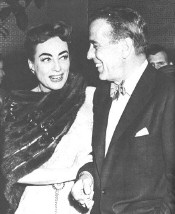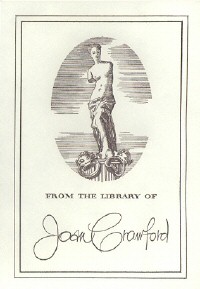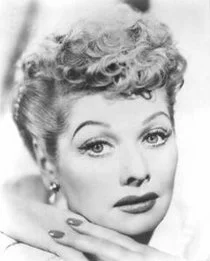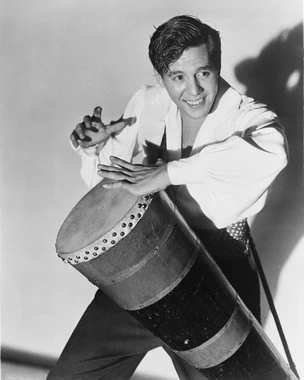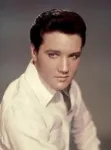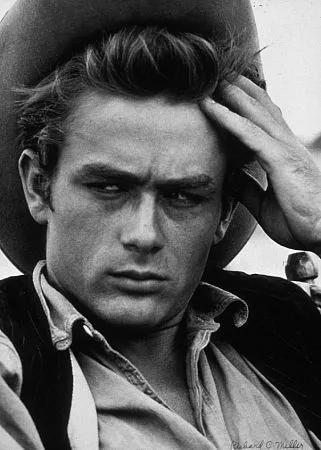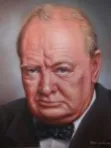Fears disappointments… Afraid of the dark.

http://www.joancrawfordbest.com/b.htm#bisexuality
http://www.garboforever.com/Joan_Crawford-3.htm
Birthdate of Joan. March 23 (an Aries), but the year varies depending on the source-text: 1904: CM, EB, MD, US.1905: LW. 1906: CWJC, JCB. Joan herself claimed to have been born in 1908, but the 1904, 1905, or 1906 dates seem more likely.
According to the sources that list 1906, this is the birth-year she gave upon registration at Stephens College in the fall of 1922 (this would have made her 16 at the time).
However, she arrived in Hollywood and signed her first contract with MGM in early 1925; MGM required parental consent if the signee were under the age of 21, and their records (according to US) don't show that she required a parent's signature--this would indicate a 1904 birthdate. (In MD, daughter Christina writes that her grandmother---Joan's mother---said Joan was born in 1904.) But one thing that goes against the 1904 date: JB says that according to 1917 Kansas City school records, her older brother Hal was born on 9/3/03 (the IMDb also gives this year for him and California death records state the same date). Joan couldn't have been born only 6 months later, unless she was premature, which no source mentions.
In favor of the 1905 date is the 1910 Comanche County census (dated April 20, 1910), which lists Joan as 5 years old. The problem with this, though, is that it lists Hal as being 8, when he was actually only 6 as of that date.
Click here to see documents requested from the city of "San Antonia" (sic) from both Joan's business manager and her mother in 1942, asking to make Joan's birth year of "1908" official. (Photo of docs from the Doyle New York auction, December 2011.)
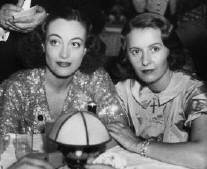 Bisexuality of Joan. In EB, author Lawrence Quirk says Joan slept with several fellow chorus girls while in NYC, and relates that Joan's press agent Jerry Asher told him Joan had a crush on early co-star Anita Page, and actually slept withDorothy Sebastian, Gwen Lee, May Clark, and Barbara Stanwyck. (Stanwyck's press agent Helen Ferguson is quoted as saying "There is no doubt in my mind that Joan and Barbara were intimate on more than one occasion.")
Bisexuality of Joan. In EB, author Lawrence Quirk says Joan slept with several fellow chorus girls while in NYC, and relates that Joan's press agent Jerry Asher told him Joan had a crush on early co-star Anita Page, and actually slept withDorothy Sebastian, Gwen Lee, May Clark, and Barbara Stanwyck. (Stanwyck's press agent Helen Ferguson is quoted as saying "There is no doubt in my mind that Joan and Barbara were intimate on more than one occasion.")
Asher also said Joan was interested in Bette Davis in the 1930s (though not at the time Baby Jane was filming, which Davis claimed), when Davis had eyes for Joan's husband Franchot Tone. Said Joan: "Franchot isn't interested in Bette, but I wouldn't mind giving her a poke if I was in the right mood. Wouldn't that be funny?" Quirk also says that in her autobiography, Martha Raye claims she slept with Joan when they were both involved with the USO during WWII.
In DF, author Shaun Considine quotes director Vincent Sherman (himself a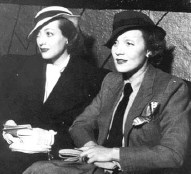 Joan-paramour) as saying, "When we were at Columbia [early '50s] there was a girl who was always hanging around [Joan]. We often wondered about her." Considine also quotes actress Louise Brooks that Joan was "one of those girls who went back and forth." And quotes photographer Cecil Beaton re Joan's frequent crushes: "At one time she was insatiably interested in Dietrich...Then she moved on to Lilyan Tashman, followed by the chief of her idols--Greta Garbo."
Joan-paramour) as saying, "When we were at Columbia [early '50s] there was a girl who was always hanging around [Joan]. We often wondered about her." Considine also quotes actress Louise Brooks that Joan was "one of those girls who went back and forth." And quotes photographer Cecil Beaton re Joan's frequent crushes: "At one time she was insatiably interested in Dietrich...Then she moved on to Lilyan Tashman, followed by the chief of her idols--Greta Garbo."
 Joan-paramour) as saying, "When we were at Columbia [early '50s] there was a girl who was always hanging around [Joan]. We often wondered about her." Considine also quotes actress Louise Brooks that Joan was "one of those girls who went back and forth." And quotes photographer Cecil Beaton re Joan's frequent crushes: "At one time she was insatiably interested in Dietrich...Then she moved on to Lilyan Tashman, followed by the chief of her idols--Greta Garbo."
Joan-paramour) as saying, "When we were at Columbia [early '50s] there was a girl who was always hanging around [Joan]. We often wondered about her." Considine also quotes actress Louise Brooks that Joan was "one of those girls who went back and forth." And quotes photographer Cecil Beaton re Joan's frequent crushes: "At one time she was insatiably interested in Dietrich...Then she moved on to Lilyan Tashman, followed by the chief of her idols--Greta Garbo."
In CM, author Jane Ellen Wayne relates that when, on the set of '32's Grand Hotel,Greta Garbo took Joan's face in her hands after a chance meeting on-set, 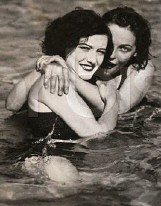 Joan was thrilled and later said, "If there was ever a time in my life when I might have become a lesbian, that was it." (Joan mentions the rather sexual excitement of this meeting in her April '73 Town Hall appearance.)
Joan was thrilled and later said, "If there was ever a time in my life when I might have become a lesbian, that was it." (Joan mentions the rather sexual excitement of this meeting in her April '73 Town Hall appearance.)
 Joan was thrilled and later said, "If there was ever a time in my life when I might have become a lesbian, that was it." (Joan mentions the rather sexual excitement of this meeting in her April '73 Town Hall appearance.)
Joan was thrilled and later said, "If there was ever a time in my life when I might have become a lesbian, that was it." (Joan mentions the rather sexual excitement of this meeting in her April '73 Town Hall appearance.)
In LW, author Fred Guiles says that Marilyn Monroe told her press agent that Joan had made a drunken pass at her one afternoon while Monroe was trying on clothes at Joan's house. In tapes made for her psychiatrist shortly before her death, published in 2003 in a book by Matthew Smith, Marilyn said of Joan: Oh yes, Crawford. We went to her house from a cocktail party, feeling no pain. We went to the bedroom and went down on each other. Crawford had a gigantic orgasm and shrieked like a maniac. Next time I saw her she wanted another round. I told her straight out I didn't enjoy it much, doing it with a woman. After I turned her down she became spiteful.
In MD, Christina says that a former nurse later told her that Joan had frequently propositioned her. Christina says she already knew about her mother's "lesbian proclivities" and so wasn't surprised at the news, but doesn't elaborate.
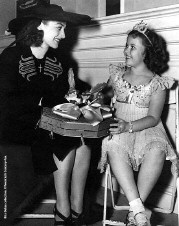 Black, Shirley Temple. (4/23/28 - ) In her book, Child Star, Black recounts how she failed an audition for the role of Joan's character as a child in 1933's Dancing Lady. She also describes a visit by Joan to her home. A mutual friend, George Murphy, brought Joan to meet Black. Joan offered her a box of Austrian chocolates saying, "Do you like candy or do they make you fat?" Black describes Joan as: ...impeccably groomed and acutely self-conscious about every fold in her skirt. Her elbow length black gloves were constantly being adjusted so as to be absolutely even, and her mannish suit of jet black elegantly framed the large golden cross at her bosom. Altogether, she was a beautiful and incandescent person, picture-postcard perfect.
Black, Shirley Temple. (4/23/28 - ) In her book, Child Star, Black recounts how she failed an audition for the role of Joan's character as a child in 1933's Dancing Lady. She also describes a visit by Joan to her home. A mutual friend, George Murphy, brought Joan to meet Black. Joan offered her a box of Austrian chocolates saying, "Do you like candy or do they make you fat?" Black describes Joan as: ...impeccably groomed and acutely self-conscious about every fold in her skirt. Her elbow length black gloves were constantly being adjusted so as to be absolutely even, and her mannish suit of jet black elegantly framed the large golden cross at her bosom. Altogether, she was a beautiful and incandescent person, picture-postcard perfect.
Later, Joan would return with adopted children Christina and Christopher and then-husband Phillip Terry. Black describes the children as having "...performed like a programmed wind-up toy." Christina peeked into her closet and remarked about the amount of clothes inside; Black said they were costumes. While Joan was examining Black's mother's glass miniatures, Christopher punched her hard on the thigh, which prompted Joan to slap him on the cheek, sending him into a fit that gained everyone's attention. Finally, Black recalls a gift that Joan gave her, a cocker spaniel puppy that died the very next day before she could name it. More Shirley info.
 Blackglama. Joan appeared in the ad campaign "What becomes a legend most?" for this mink company in 1969. See the Blackglama site (Campaign: Legends) for more info on the "Legends" series. See also the Ads page of this site for more Joan endorsements.
Blackglama. Joan appeared in the ad campaign "What becomes a legend most?" for this mink company in 1969. See the Blackglama site (Campaign: Legends) for more info on the "Legends" series. See also the Ads page of this site for more Joan endorsements.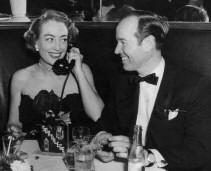 Blackwell, Earl. (1910 - 1995) Friend of Joan and celebrity promoter (he founded "Celebrity Services" in 1939). He made the call to Joan's dressing room on the set of Female on the Beach on New Year's Eve 1954, telling her that Al Steele wished to speak with her.
Blackwell, Earl. (1910 - 1995) Friend of Joan and celebrity promoter (he founded "Celebrity Services" in 1939). He made the call to Joan's dressing room on the set of Female on the Beach on New Year's Eve 1954, telling her that Al Steele wished to speak with her.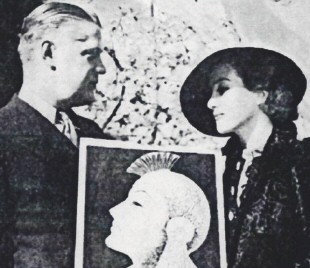 Blanding, Don. (11/7/1894 - 6/9/57) Poet and artist and teenaged neighbor of Joan's in Lawton, Oklahoma. She cut her foot severely when she was 6, and Blanding was the one who carried her inside her house and called the doctor. In 1935 he wrote the following about his memories of her (the two also met again on the set of 1936's Gorgeous Hussy):
Blanding, Don. (11/7/1894 - 6/9/57) Poet and artist and teenaged neighbor of Joan's in Lawton, Oklahoma. She cut her foot severely when she was 6, and Blanding was the one who carried her inside her house and called the doctor. In 1935 he wrote the following about his memories of her (the two also met again on the set of 1936's Gorgeous Hussy):
THE LITTLE GIRL ACROSS THE STREET
She was just the little girl who lived across the street, All legs and curls and great big eyes and restless dancing feet, As vivid as a humming bird, as bright and swift and gay, A child who played at make-believe throughout the livelong day. With tattered old lace curtains and a battered feather fan She swept and preened, an "actress" with grubby snub-nosed clan Of neighborhood kids for audience enchanted with the play, A prairie Bernhardt for a while. And then she went away. We missed her on the little street, her laughter and her fun Until the dull years blurred her name as years have ever done. . . . . . A great premiere in Hollywood... the light, the crowds, the cars, The frenzied noise of greeting to the famous movie stars, The jewels, the lace, the ermine coats, the ballyhoo and cries, The peacock women's promenade, the bright mascaraed eyes.... The swift excited whisper as a limousine draws near, "Oh, look! It's Joan. It's Joan. It's Joan!" On every side I hear The chatter, gossip, envy, sighs, conjectures, wonder, praise, As memory races quickly back to early prairie days. The little girl across the street... the funny child I knew Who dared to dream her splendid dreams... and make her dreams come true. |
Bloch, Robert. Most famous for his Psycho screenplay for Hitchcock, he also wrote the screenplay for Joan's '64 filmStrait-Jacket.
Blondell, Joan. This veteran actress was initially slated for Joan's role in 1964's Strait-Jacket, but an accident prevented her from taking the part.
Bloody Mary. In LY, Joan instructs author Carl Johnes how to make one: "Always use Snap-e-Tom, never tomato juice!"
Junkies down in Brooklyn are going crazy
They’re laughing just like hungry dogs in the street Policemen are hiding behind the skirts of little girls Their eyes have turned the color of frozen meat No, no, no, no, no, no, no, no, no, no, no, no Joan Crawford has risen from the grave Joan Crawford has risen from the grave Catholic school girls have thrown away their mascara They chain themselves to the axles of big mac trucks The sky is filled with herds of shivering angels The fat lady laughs, "gentlemen, start your trucks" Oh no, no, no, no, no, no, no, no, no, no, no Joan Crawford has risen from the grave Joan Crawford has risen from the grave Christina Mother’s home Christina Come to mother Christina
No, no, no, no, no, no, no, no, no, no, no, no
Joan Crawford has risen from the grave Joan Crawford has risen from the grave Joan Crawford has risen from the grave Joan Crawford has risen |
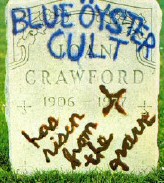
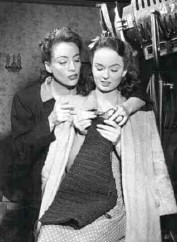 Blyth, Ann. (8/16/28 - ) Initially a Broadway actress, Blyth came to Hollywood at age 15 and acted in 4 musicals for Universal before playing Evil Daughter Veda in '45'sMildred Pierce, for which she received an Oscar nomination. Joan and Blyth got along well (Joan rehearsing extensively with her when studio execs were at first reluctant to cast her as Veda, thinking she was too "sweet"). Blyth acted in films up until the '50s, and made TV appearance into the '80s. Today, Turner Classic Movies occasionally runs a 5-minute spot featuring her affectionate remembrances of working with Joan.
Blyth, Ann. (8/16/28 - ) Initially a Broadway actress, Blyth came to Hollywood at age 15 and acted in 4 musicals for Universal before playing Evil Daughter Veda in '45'sMildred Pierce, for which she received an Oscar nomination. Joan and Blyth got along well (Joan rehearsing extensively with her when studio execs were at first reluctant to cast her as Veda, thinking she was too "sweet"). Blyth acted in films up until the '50s, and made TV appearance into the '80s. Today, Turner Classic Movies occasionally runs a 5-minute spot featuring her affectionate remembrances of working with Joan.
In July 2006, Blyth was interviewed at San Francisco's Castro Theatre after a showing ofMildred Pierce. Click here to see photos from this event.
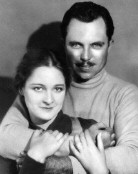 Boardman, Eleanor. (8/19/1898 - 12/12/1991) Silent actress, star of 1925's The Only Thing,The Circle, and Proud Flesh, in which Joan also appeared. Boardman was married to directorKing Vidor, and the couple had Joan over for brunch and swimming occasionally in the mid-20s.(LW)
Boardman, Eleanor. (8/19/1898 - 12/12/1991) Silent actress, star of 1925's The Only Thing,The Circle, and Proud Flesh, in which Joan also appeared. Boardman was married to directorKing Vidor, and the couple had Joan over for brunch and swimming occasionally in the mid-20s.(LW)
Movie Stars? I don't like the name. The words 'movie stars' are so misused they have no meaning. Any little pinhead who does one picture is a Star. Gable is a star, Cooper is a star, Joan Crawford, as much as I dislike the lady, is a star, but I don't think the so-called others are.
(If you know the year/setting of this quote, please e-mail me.) Thanks to Debbie for providing the above quote.
Boleslawski, Richard. Director of Joan's '37 film The Last of Mrs. Cheyney. He died during the filming, which was completed by Dorothy Arzner.
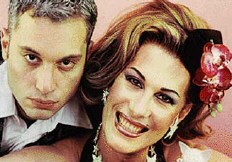 Bond, Justin. Performance artist Bond developed the stage character of the anarchic 60-something "boozy chanteusie" Kiki DuRane in the mid-90s; he and Kenny Mellman (aka "Herb," Kiki's accompanist/accomplice/collaborator) have since performed as "Kiki and Herb" in New York City cabaret venues as well as making special appearances across the country and in London. (The two gave their "Farewell Concert" at Carnegie Hall in September 2004.) A May 2003 article in Next magazine said : "Sounding like Shirley Bassey filtered through Lauren Bacall, Justin Bond embodies Kiki with the determination of Joan Crawford, the glamour of Lypsinka, and the tongue-in-cheek delivery of Charles Busch."
Bond, Justin. Performance artist Bond developed the stage character of the anarchic 60-something "boozy chanteusie" Kiki DuRane in the mid-90s; he and Kenny Mellman (aka "Herb," Kiki's accompanist/accomplice/collaborator) have since performed as "Kiki and Herb" in New York City cabaret venues as well as making special appearances across the country and in London. (The two gave their "Farewell Concert" at Carnegie Hall in September 2004.) A May 2003 article in Next magazine said : "Sounding like Shirley Bassey filtered through Lauren Bacall, Justin Bond embodies Kiki with the determination of Joan Crawford, the glamour of Lypsinka, and the tongue-in-cheek delivery of Charles Busch."
Bond also collaborated with Bob Ostertag and Otomo Yoshihide in the electronic/experimental noise band PantyChrist. Again, for some reason there are Joan references in reviews: "Justin Bond...has one of those inimitable voices that sounds like Joan Crawford after an acid bath....So if your idea of a good time involves listening to a CD that variously puts one in mind of Jerry Lewis enduring a painful prostate examination, a video game gone haywire,...or the modern audio equivalent of Whatever Happened to Baby Jane?, then PantyChrist is for you."
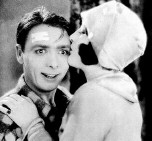 Boob, The. MGM silent, 1926. Directed by William A. Wellman, 64 minutes. Joan plays "Jane," a prohibition agent. George K. Arthur stars as a country bumpkin good-guy. Said Joan: ...a disaster, even with George K. Arthur. The script was terrible and I simply wasn't cut out for slapstick. (CWJC) In a 1926 letter to a fan, she wrote (with original punctuation shown): I just found out, a picture I made over a year ago called 'Ill Tell the World' Has been released under-'The Boob'. Im so sorry I made such a dreadful mistake. Will you forgive me? You dont need to tell me it was a terrible picture. How well I know. I wouldnt even go to see the preview.
Boob, The. MGM silent, 1926. Directed by William A. Wellman, 64 minutes. Joan plays "Jane," a prohibition agent. George K. Arthur stars as a country bumpkin good-guy. Said Joan: ...a disaster, even with George K. Arthur. The script was terrible and I simply wasn't cut out for slapstick. (CWJC) In a 1926 letter to a fan, she wrote (with original punctuation shown): I just found out, a picture I made over a year ago called 'Ill Tell the World' Has been released under-'The Boob'. Im so sorry I made such a dreadful mistake. Will you forgive me? You dont need to tell me it was a terrible picture. How well I know. I wouldnt even go to see the preview.
Borgnine, Ernest. Co-star of Johnny Guitar.
Borzage, Frank. Directed 4 of Joan's films: 1925's The Circle, '37's Mannequin, '38's The Shining Hour, and '40'sStrange Cargo.
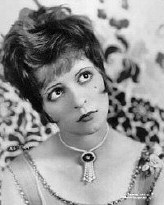 Bow, Clara. (7/29/05 - 9/27/65) Known as Hollywood's, and America's, "It"-Girl in her silent-film heyday, the Brooklyn-tenement-born Bow made 57 films between 1922 and her retirement in 1933 to marry cowboy star (later Nevada political candidate) Rex Bell.
Bow, Clara. (7/29/05 - 9/27/65) Known as Hollywood's, and America's, "It"-Girl in her silent-film heyday, the Brooklyn-tenement-born Bow made 57 films between 1922 and her retirement in 1933 to marry cowboy star (later Nevada political candidate) Rex Bell.
In a November 16, 1933, interview with John C. Moffitt in the Kansas City Star, Bow spoke about her Hollywood flapper days and about Joan:
"It's funny. I really learned a lot during those dizzy years when Joan Crawford and I were running around town as the two hey-hey girls of Hollywood. Nobody thought I was learning anything. It seems rather funny to think that I was a sort of trademark for the flapper. The 'flapper' as a type seems about as antiquated as the suffragette or the vestal virgin, but I can remember when the whole country was standing on its ear over flappers. They yelled about us in the pulpits and long-haired guys denounced us in the press. They made a world menace of us and all we were was a bunch of dizzy little gals with our skirts up to our knees and with Fiji Island haircuts. It seems sort of funny that anyone should have taken us seriously. But,boy, you should have seen some of the 'sinner beware!' letters I got."
...Clara then grinned and continued: "My life in Hollywood contained plenty of uproar. I'm sorry for a lot of it but not awfully sorry. I never did anything to hurt anyone else. I made a place for myself on the screen and you can't do that by being Mrs. Alcott's idea of a little woman. Hollywood always reminds me of one of those French Revolution pictures where the women are hollering and waving pitchforks twice as violently as any of the guys are. The only ladies in sight are the ones getting their heads cut off."
With that, Clara gave "what looked suspiciously like a sigh" and added: "Anyhow, we got what we wanted out of it." She then spoke about her present off-screen life and that of her fellow flapper: "Joan Crawford called me up the other day and I didn't know her. She had one of those trick English accents and a Lady Vere-de-Vere voice. She's been married to the son of the royal family and she's running around with Franchot Tone, who they tell me represents the spirit of Cornell and aristocracy on the hoof. Joan's gone a long way from the Charleston contests and you can bet your life she's got what she wants...."
Thanks to Greg for passing along William M. Drew's find.
Box Office Poison. In 1938, Harry Brandt, president of the Independent Theater Owners of America, published an article in The Independent Film Journal complaining about the unappealing (and non-money-making) films being released to theaters. Contrary to popular belief, the main complaint wasn't primarily the stars, but the quality of the subject matter of the films. Said the article: Among those players whose dramatic ability is unquestioned, but whose box-office draw is nil, can be numbered Mae West, Edward Arnold, Greta Garbo, Joan Crawford, Katharine Hepburn, Marlene Dietrich, and Fred Astaire. (CM)
Branch, Dr. William. Joan's physician who declared her unfit to attend the Academy Awards on the night of her Mildred Pierce victory. Fortunately, her alleged fever of 104 broke after the radio announcement of her win, and Branch allowed her to greet well-wishers and reporters. She had initially personally consulted Branch in 1926; 8 years later, the two teamed up to create a Crawford-Branch clinic within the Hollywood Presbyterian Hospital to treat needy industry cases. And trooper Branch also helpfully stood by during her very first radio broadcast (on Bing Crosby's show) in 1935 in case she needed medical attention. (JCB)
Brandeis University. Home of the Joan Crawford Dance Studio (dedicated in 1965 and located within the school's Spingold Theater Arts Center). Joan became a Brandeis Fellow in 1967, "given her interest, time and service to a host of civic and philanthropic causes which has endeared her to a large public that goes well beyond the pale of the entertainment industry." In 1966, 1968, and 1973, Joan donated a variety of theater, community, and business awards to the school, which can be seen on these Brandeis Joan Crawford Award Collection web pages.
Brando, Marlon. (4/3/1924 - 7/1/2004) Brando was rumored to have been wanted by Joan as a co-star for two of her films, 1952's Sudden Fear and 1956's Autumn Leaves. In 1951, Joan had admired Brando in his Streetcar Named Desire performance and sent him a congratulatory telegram after its debut. When it was time for filming on Fear to begin, she submitted the script to Brando's agent; Brando sent it back, rudely saying that he wasn't interested in doing "any mother-and-son pictures at the present time." (DF)
Both the Thomas and Quirk bios report that Joan wanted Brando for Leaves; the latter source, though, also quotes Joan as saying around this time about Brando's looks: "There's something flat and dead about his eyes. Brando doesn't really have the handsomeness of a Clark Gable or a Cary Grant. They were well-groomed and intelligent looking. Brando looks like he changes his underwear about every two weeks." Joan's antipathy would continue into the '70s. In CWJC, she says, re Brando in Last Tango in Paris: "He's at least forty pounds overweight, and I think the only sex appeal he has would be to a meat packer."
Brandt, Harry. See Box Office Poison.
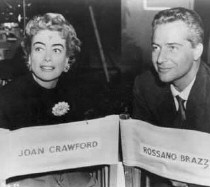 Brazzi, Rossano. Italian film star, co-starred as the villainous husband in 1957'sStory of Esther Costello.
Brazzi, Rossano. Italian film star, co-starred as the villainous husband in 1957'sStory of Esther Costello.
Breen, Joseph L. Appointed head of the "moral watchdog" Hays Office in 1934. The first film to catch some flak? Joan's Forsaking All Others ('34), for reasons of a "cynical twist in the title's religiosity," plus a few too-daring lines.(US)
Bremen, The. The ship on which Joan and husband Doug Fairbanks travelled to Europe in 1932 in a failed effort to bolster their marriage.
 Brian, David. Joan's co-star in '49's Flamingo Road, '50's The Damned Don't Cry, and '52's This Woman Is Dangerous.
Brian, David. Joan's co-star in '49's Flamingo Road, '50's The Damned Don't Cry, and '52's This Woman Is Dangerous.
Brian, Mary. A WAMPAS Baby Star with Joan in 1926, she consoled Joan at graveside in 1958 when her mother died. (Both of their mothers had been active in the Motion Picture Mothers association.) (JCB)
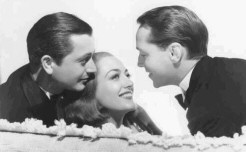 Bride Wore Red, The. MGM, 1937. Directed by Dorothy Arzner, 103 minutes. Joan stars as "Anni," a cabaret singer masquerading as a society girl to land a rich man, in her 7th and final film with husband Franchot Tone. (Robert Young plays the rich guy, and Tone the rather fruity flute-playing postman who loves her.) Joan had looked forward to working with a female director, but by the end of filming, she and Arzner weren't speaking. (JCB)Said Joan in CWJC: ...a waste of time for everyone but I guess it made money because that "Crawford" audience went to see it loyally. But what a botch.
Bride Wore Red, The. MGM, 1937. Directed by Dorothy Arzner, 103 minutes. Joan stars as "Anni," a cabaret singer masquerading as a society girl to land a rich man, in her 7th and final film with husband Franchot Tone. (Robert Young plays the rich guy, and Tone the rather fruity flute-playing postman who loves her.) Joan had looked forward to working with a female director, but by the end of filming, she and Arzner weren't speaking. (JCB)Said Joan in CWJC: ...a waste of time for everyone but I guess it made money because that "Crawford" audience went to see it loyally. But what a botch.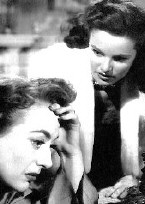 Brooks, Geraldine. (10/29/25 - 6/19/77) This actress had a brief film career in the '40s before going on to a 25-year TV career. She plays Joan's stepdaughter in 1947'sPossessed. Brooks also gave a eulogy at Joan's memorial service in NYC, May 17, 1977.
Brooks, Geraldine. (10/29/25 - 6/19/77) This actress had a brief film career in the '40s before going on to a 25-year TV career. She plays Joan's stepdaughter in 1947'sPossessed. Brooks also gave a eulogy at Joan's memorial service in NYC, May 17, 1977.http://mikeresponts.wordpress.com/2008/05/17/sickest-book-of-all-time/
Among the allegations the book makes are:
Lucille Ball got her start in Hollywood as a hooker.
Lucy was a whore. Elvis had gay sex. Bette Davis was a murderer. And you don’t even want to know what happened to Judy Garland.
The latest column by Rush & Molloy has a preview of the upcoming book “Hollywood Babylon: It’s Back.”
“Hollywood Armageddon” might be a more like it.
The book dishes unbelievably horrific dirt on some of the biggest tv and screen icons EVER. To quote Rush & Malloy the book’s authors ”have dared to publish the pictures and stories too explicit and actionable for even the pulpiest supermarket tabloids.”
After all, thirty years after his death, Bing Crosby is still remembered as a guy who beat his kids because of what was written in ONE book. The same thing is true for Joan “Mommy Dearest” Crawford.
Meanwhile her husband, Desi Arnaz (known to millions of adoring 50′s tv fans as Ricky Ricardo on I Love Lucy), is alleged in “Hollywood Babylon” to have had a homosexual affair with actor Cesar Romero.
The alleged Arnaz/Romero homosexual affair is far from the most notorious claim in “Hollywood Babylon.”
Elvis had gay sex with 60′s tv and movie actor Nick Adams (a well-known member of Presley’s inner circle and entourage.)
There have been plenty of Hollywood stories about the legendary actor James Dean being gay or bisexual.
“Hollywood Babylon” goes into detail about Dean’s “disconcerting interest” in a 12-year-old boy in the early 50′s. Not only that, but the book has an on-the-record quote from director Elia Kazan who said he believed the allegations,
“I’ve known many actors who have been twisted up in their sex lives, but never anybody as sick and unhealthy as Dean was.”
“Hollywood Babylon” says not only was actor Cary Grant involved in gay sex,
but he had INCESTUOUS gay sex with his own stepson, Lance Reventlow.
The column also says the book accuses Bette Davis (the most decorated actress in the history of the Academy Awards) of being a murderer.
Police believed Bette Davis killed her second husband, Arthur Farnsworth, by hitting him on the head and causing a hemorrhage that lead to his death two weeks later. But a grand jury – six men who confessed to being ardent fans – found her innocent.
That is one allegation in the book that has been proven to be BASICALLY true. Police DID suspect Davis in the death and a grand jury was convened which refused to press charges. However, whether Bette Davis was guilty or not is sheer speculation by the book’s authors.
There’s even an item about Winston Churchill engaging in a bit of buggery with an effeminate songwriter.
quote;
I remember when Hollywood Babylon 1 and 2 came out and it brought alot of stuff to light, which was both good and bad. Good, because the lurid stories made the silver screen legends look mortal. Bad, because the lurid stories were true and was probably worse than reported. Jesus, I love Turner Classic Movies, but I cringe when I see Clark Gable. Because of Babylon, I now only remember the HB story of how Rhett Butler had to suck alot of dick to get good movie roles. Literally.
Lucy had to hook. So did Joan Crawford. In fact, all actresses were exploited in the studio era, in some form. Probably hard to imagine, but many male actors had to succumb to that, as well.
I always liked the HB stories of how the celebs got away with murder. That Bette Davis story intrigues me — never knew that, I love shit like that. Just like Lana Turner’s daughter who was acquitted of killing her step father — Lana gave a tear filled courtroom plea worthy of an Oscar. The jury filled with men who adored her, boom, acquittal. I love these stories because it spotlights our society’s love and forgiveness for celebrities. Bette Davis was one ugly bitch, anyway.
However, I do agree with you Mike. It appears the latest HB is all about showing famous nudes. If I was the publisher of Celebrity Skin, I’d be pissed off for someone stealing their gig. Ah yes, Hollywood Babylon: We love it, we hate it, yet we need it all the same. Great Story, Mr. Responts.
------------------------
http://www.hollywoodsgoldenage.com/actors/joan_crawford.html
Joan Crawford (1905-1977)

Joan Crawford
Joan Crawford was one of the greatest of the movie actresses of Hollywood's Golden Age. She was a top star for several decades, cleverly renewing her image at regular intervals, so ensuring that she had one of the longest-ever movie careers in Hollywood. She always had great charisma, great style and hers is a true rags-to-riches story of a lowly chorus girl rising to the heights of show business success to rival all the great names of Hollywood.
She succeeded through talent, great beauty, huge determination and boundless energy. Joan Crawford's life is one to be proud of. This is her story.
Biography
Joan was born Lucille Fay LeSueur on March 23 in 1905 or 1906, in San Antonio, Texas. There is some dispute over the year of her birth, but 1905 seems to be the more likely. She only knew her natural father later in life as he and her mother divorced just after her birth. She and her older brother Hal were brought up by her mother and stepfather, Harry Cassin, whom her mother married in 1907. As a child she was known as Billie Cassin. Cassin, who owned a vaudeville theater, introduced young Joan to the theatrical world and encouraged her growing interest in dancing and acting.
In 1912 Joan cut her foot on broken glass whilst playing with friends. This seemingly trivial injury turned out to be extremely serious and caused her to have 3 operations and to be off school for a year and a half. With typical determination she continued to dream of becoming a professional dancer and as soon as she entered her teens she started to neglect her schooling in favour of practising for and entering dance competitions, which she frequently won.
By 1916 the family moved to Kansa City. Her mother and Cassin split up and Joan was sent to the Rockingham Academy where she had to work as a maid in return for her keep and her lessons.
When Joan left school aged 16 she spent several months in department store jobs and started to train as a phone operator. Life was dull for the vivacious young girl and she returned to her first love - dancing. She auditioned for an agent/producer in Chicago and was accepted for chorus line work in revues travelling along the East coast. The teenage Joan was a charismatic bundle of energy and oozing sex apeal. For two years she worked as a chorus line dancer in small, sleazy nighclubs along the Atlantic coast before being spotted in 1924 by New York producer J.J. Schubert who hired her for the chorus of his Broadway production of 'Innocent Eyes'. She was eventually spotted by MGM agent Harry Rapf and she moved to Hollywood and signed a contract with MGM in 1925.
In 1925 Joan Crawford was still known as Lucille LeSueur. Under that name she made six films, until MGM decided to hold a Photoplay magazine contest to rename her and the name 'Joan Crawford' was chosen. It was a new start for Joan and it marked the start of her rise to Hollywood stardom.
She made her debut under her new name in 'Pretty Ladies' in 1925 and made several more light hearted 'flapper' movies during the next 2 years. She was well thought of by MGM and Louis B Mayer in particular, and she climbed the ladder rapidly. In 1928 she had her first big success with 'Our Dancing Daughters'. It transformed her career completely, and from then on she was regarded as one of the foremost actresses in MGM. For the next few years Joan used her image as the typical flapper to great advantage and she came to symbolize the youthful vigour of the Jazz Age.
The arrival of sound at the end of the 1920's proved to be a major hurdle to some stars, but not to Joan. With her powerful voice to add to her armoury, she sailed serenely on and indeed became a bigger star still with movies such as 'Paid' in 1930, 'Dance, Fools, Dance' in 1931, her first movie with Clark Gable; 'Possessed’ in 1931; and, above all, 'Grand Hotel' in 1932. This last enabled Joan to take on Greta Garbo, one of her main rivals at MGM, and come out favourably, and marked Crawford's entrance into the rarified air of the Hollywood superstar.
After 'Grand Hotel' 'Rain in 1932, was a relative failure but then Joan was able to transform her image from flapper to sophisticate, in films such as 'Letty Lynton' in 1932, 'Today We Live’ in 1933, 'Sadie McKee' and 'Chained' in 1934, 'No More Ladies' and 'I Live My Life' in 1935 and 'The Last of Mrs Cheyney' in 1937. In these films her character was invariably that of a lower class woman, unlucky in love, who tried to better herself with rich, powerful men.
After 'Love on the Run' in 1936, with Gable, and 'Mannequin' the following year with Spencer Tracy, Joan was crowned "Queen of the Movies" by Life magazine and her position at the top of the Hollywood hierarchy seemed secure. She had another success with 'The Women' in 1939 directed by George Cukor, where she more than held her own with a very strong all-female cast.
Her last years with MGM were difficult ones and with 'Strange Cargo' and 'Susan and God' in 1940 and 'A Woman's Face' in 1941, she began to feel that MGM was not giving her the roles she wanted. She decided to leave the studio and immediately was signed up by Warner Bros. Joan was about to re-invent herself once more and go through a golden period of movie creativity.
Her new image was as the middle aged career woman and she displayed it to perfection in 1945 in the title role of 'Mildred Pierce', her first film as a mother, and which won her a Best Actress Oscar. Her new image and run of success continued with the melodramas 'Humoresque' in 1946 and 'Possessed' in 1947. Joan's moving and disturbing portrayal of mental illness in 'Possessed' brought her a second Oscar nomination.
Unfortunately for Joan the supply of good scripts began to dry up. In 1947 she was loaned out to 20th Century-Fox for 'Daisy Kenyon', taking part in yet another predictable love triangle with Dana Andrews and Henry Fonda. The following year there were no suitable scripts at all and from 1949 until the end of her contract with Warners in 1952 there was a series of implausible and disappointing soap operas like 'Flamingo Road', 'The Damned Don't Cry' and 'Goodbye, My Fancy'. Joan was able to pick one good role in this period, that of Myra Hudson in Sudden Fear in 1952. Again she was nominated for Best Actress Oscar, but again she was disappointed.
In 1952 Joan was released for her contract with Warners and it marked the start of a downward trend in her career. As she grew older and stronger, so her films and even her male stars seemed to become weaker. In 1954, in 'Johnny Guitar' it was all Sterling Hayden could do to stand up to her in recriminating dialogues. And in 1957 she was the horrified guardian of a raped girl in 'The Story of Esther Costello'. Only Robert Aldrich rescued her from dross - in 'Autumn Leaves' in 1956 and most successfully in 'What Ever Happened to Baby Jane?' in 1962, withBette Davis.
She went on to more grotesque movie appearances in the horror film genre, chiefly in the hands of William Castle: 'Strait Jacket' in 1964 and 'I Saw What You Did' in 1965 and she also played a ring mistress in 'Berserk!' in 1967. None of these late movies exactly enhanced her reputation and, as she was financially secure, her motives for doing them remain a mystery.
Joan embraced the new medium of television and from 1953 on she made some 100 apearances in Game Shows like 'I've Got a Secret', the 'Zane Grey Theater', as well as cameo apperances on Steve Allen's Tonight Show. The material was uniformly bad and did not adequately showcase her talents. She emerged as a camp parody of her former self.
Joan's final movie appearance only made things worse. It was an awful flop called 'Trog' made in 1970. She had an increasing alchohol dependancy problem during her final years and she died in New York City in May, 1977, of liver cancer. She was 73 years old.
Joan Crawford Academy Awards
One Win:Best Actress ... Mildred Pierce (1945)
Two Unsuccessful Nominations:
Best Actress ... Possessed (1947)
Best Actress ... Sudden Fear (1952)
Joan Crawford Filmography
1925
Pretty Ladies (as Lucille Le Sueur)
A Slave of Fashion (uncredited)
The Merry Widow (uncredited)
The Circle
Old Clothes
The Only Thing (uncredited)
Sally, Irene and Mary
Ben-Hur: A Tale of the Christ (uncredited)
Pretty Ladies (as Lucille Le Sueur)
A Slave of Fashion (uncredited)
The Merry Widow (uncredited)
The Circle
Old Clothes
The Only Thing (uncredited)
Sally, Irene and Mary
Ben-Hur: A Tale of the Christ (uncredited)
1926
Tramp, Tramp, Tramp
The Yokel
Paris
Tramp, Tramp, Tramp
The Yokel
Paris
1927
Winners of the Wilderness
The Taxi Dancer
The Understanding Heart
The Unknown
Twelve Miles Out
Spring Fever
West Point
Winners of the Wilderness
The Taxi Dancer
The Understanding Heart
The Unknown
Twelve Miles Out
Spring Fever
West Point
1928
The Law of the Range
Rose-Marie
Across to Singapore
Four Walls
Our Dancing Daughters
Dream of Love
The Law of the Range
Rose-Marie
Across to Singapore
Four Walls
Our Dancing Daughters
Dream of Love
1929
The Duke Steps Out
Tide of Empire
Our Modern Maidens
Untamed
The Duke Steps Out
Tide of Empire
Our Modern Maidens
Untamed
1930
Great Day
Montana Moon
Our Blushing Brides
Within the Law
Great Day
Montana Moon
Our Blushing Brides
Within the Law
1931
Dance, Fools, Dance
Laughing Sinners
This Modern Age
Possessed
Dance, Fools, Dance
Laughing Sinners
This Modern Age
Possessed
1933
Today We Live
Dancing Lady
Today We Live
Dancing Lady
1934
Sadie McKee
Chained
Forsaking All Others
Sadie McKee
Chained
Forsaking All Others
1935
No More Ladies
I Live My Life
No More Ladies
I Live My Life
1936
The Gorgeous Hussy
Love on the Run
The Gorgeous Hussy
Love on the Run
1937
The Last of Mrs. Cheyney
The Bride Wore Red
Mannequin
The Last of Mrs. Cheyney
The Bride Wore Red
Mannequin
1938
The Shining Hour
The Shining Hour
1939
The Ice Follies of 1939
The Women
The Ice Follies of 1939
The Women
1940
Strange Cargo
The Gay Mrs. Trexel
Strange Cargo
The Gay Mrs. Trexel
1941
A Woman's Face
When Ladies Meet
A Woman's Face
When Ladies Meet
1942
They All Kissed the Bride
Mademoiselle France
They All Kissed the Bride
Mademoiselle France
1943
Above Suspicion
Above Suspicion
1944
1950
The Damned Don't Cry
Harriet Craig
The Damned Don't Cry
Harriet Craig
1951
Goodbye, My Fancy
Goodbye, My Fancy
1952
This Woman Is Dangerous
Sudden Fear
This Woman Is Dangerous
Sudden Fear
1953
Torch Song
Torch Song
1954
Johnny Guitar
Johnny Guitar
1955
Female on the Beach
Queen Bee
Female on the Beach
Queen Bee
1956
Autumn Leaves
Autumn Leaves
1957
The Story of Esther Costello
The Story of Esther Costello
1958
1959
The Best of Everything
The Best of Everything
1960
1961
1962
What Ever Happened to Baby Jane?
What Ever Happened to Baby Jane?
1963
Borderlines
Borderlines
1964
Della
Strait-Jacket
Hush...Hush, Sweet Charlotte (uncredited)
Della
Strait-Jacket
Hush...Hush, Sweet Charlotte (uncredited)
1965
I Saw What You Did
I Saw What You Did
1966
1967
Berserk
Berserk
1968
Journey to Midnight (scenes deleted)
Journey to Midnight (scenes deleted)
1969
